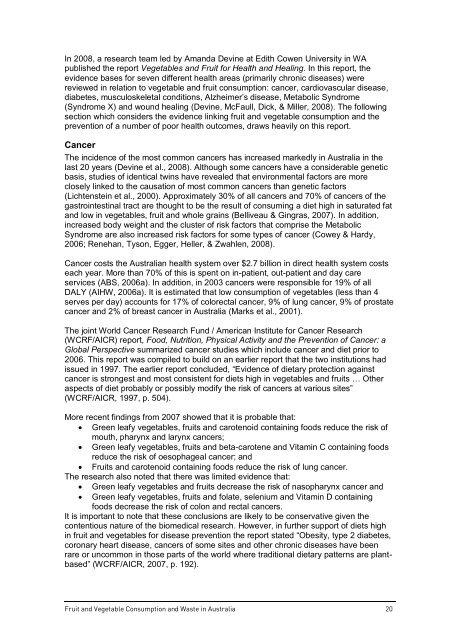Fruit and vegetable consumption and waste in Australia - VicHealth
Fruit and vegetable consumption and waste in Australia - VicHealth
Fruit and vegetable consumption and waste in Australia - VicHealth
Create successful ePaper yourself
Turn your PDF publications into a flip-book with our unique Google optimized e-Paper software.
In 2008, a research team led by Am<strong>and</strong>a Dev<strong>in</strong>e at Edith Cowen University <strong>in</strong> WA<br />
published the report Vegetables <strong>and</strong> <strong>Fruit</strong> for Health <strong>and</strong> Heal<strong>in</strong>g. In this report, the<br />
evidence bases for seven different health areas (primarily chronic diseases) were<br />
reviewed <strong>in</strong> relation to <strong>vegetable</strong> <strong>and</strong> fruit <strong>consumption</strong>: cancer, cardiovascular disease,<br />
diabetes, musculoskeletal conditions, Alzheimer’s disease, Metabolic Syndrome<br />
(Syndrome X) <strong>and</strong> wound heal<strong>in</strong>g (Dev<strong>in</strong>e, McFaull, Dick, & Miller, 2008). The follow<strong>in</strong>g<br />
section which considers the evidence l<strong>in</strong>k<strong>in</strong>g fruit <strong>and</strong> <strong>vegetable</strong> <strong>consumption</strong> <strong>and</strong> the<br />
prevention of a number of poor health outcomes, draws heavily on this report.<br />
Cancer<br />
The <strong>in</strong>cidence of the most common cancers has <strong>in</strong>creased markedly <strong>in</strong> <strong>Australia</strong> <strong>in</strong> the<br />
last 20 years (Dev<strong>in</strong>e et al., 2008). Although some cancers have a considerable genetic<br />
basis, studies of identical tw<strong>in</strong>s have revealed that environmental factors are more<br />
closely l<strong>in</strong>ked to the causation of most common cancers than genetic factors<br />
(Lichtenste<strong>in</strong> et al., 2000). Approximately 30% of all cancers <strong>and</strong> 70% of cancers of the<br />
gastro<strong>in</strong>test<strong>in</strong>al tract are thought to be the result of consum<strong>in</strong>g a diet high <strong>in</strong> saturated fat<br />
<strong>and</strong> low <strong>in</strong> <strong>vegetable</strong>s, fruit <strong>and</strong> whole gra<strong>in</strong>s (Belliveau & G<strong>in</strong>gras, 2007). In addition,<br />
<strong>in</strong>creased body weight <strong>and</strong> the cluster of risk factors that comprise the Metabolic<br />
Syndrome are also <strong>in</strong>creased risk factors for some types of cancer (Cowey & Hardy,<br />
2006; Renehan, Tyson, Egger, Heller, & Zwahlen, 2008).<br />
Cancer costs the <strong>Australia</strong>n health system over $2.7 billion <strong>in</strong> direct health system costs<br />
each year. More than 70% of this is spent on <strong>in</strong>-patient, out-patient <strong>and</strong> day care<br />
services (ABS, 2006a). In addition, <strong>in</strong> 2003 cancers were responsible for 19% of all<br />
DALY (AIHW, 2006a). It is estimated that low <strong>consumption</strong> of <strong>vegetable</strong>s (less than 4<br />
serves per day) accounts for 17% of colorectal cancer, 9% of lung cancer, 9% of prostate<br />
cancer <strong>and</strong> 2% of breast cancer <strong>in</strong> <strong>Australia</strong> (Marks et al., 2001).<br />
The jo<strong>in</strong>t World Cancer Research Fund / American Institute for Cancer Research<br />
(WCRF/AICR) report, Food, Nutrition, Physical Activity <strong>and</strong> the Prevention of Cancer: a<br />
Global Perspective summarized cancer studies which <strong>in</strong>clude cancer <strong>and</strong> diet prior to<br />
2006. This report was compiled to build on an earlier report that the two <strong>in</strong>stitutions had<br />
issued <strong>in</strong> 1997. The earlier report concluded, “Evidence of dietary protection aga<strong>in</strong>st<br />
cancer is strongest <strong>and</strong> most consistent for diets high <strong>in</strong> <strong>vegetable</strong>s <strong>and</strong> fruits … Other<br />
aspects of diet probably or possibly modify the risk of cancers at various sites”<br />
(WCRF/AICR, 1997, p. 504).<br />
More recent f<strong>in</strong>d<strong>in</strong>gs from 2007 showed that it is probable that:<br />
� Green leafy <strong>vegetable</strong>s, fruits <strong>and</strong> carotenoid conta<strong>in</strong><strong>in</strong>g foods reduce the risk of<br />
mouth, pharynx <strong>and</strong> larynx cancers;<br />
� Green leafy <strong>vegetable</strong>s, fruits <strong>and</strong> beta-carotene <strong>and</strong> Vitam<strong>in</strong> C conta<strong>in</strong><strong>in</strong>g foods<br />
reduce the risk of oesophageal cancer; <strong>and</strong><br />
� <strong>Fruit</strong>s <strong>and</strong> carotenoid conta<strong>in</strong><strong>in</strong>g foods reduce the risk of lung cancer.<br />
The research also noted that there was limited evidence that:<br />
� Green leafy <strong>vegetable</strong>s <strong>and</strong> fruits decrease the risk of nasopharynx cancer <strong>and</strong><br />
� Green leafy <strong>vegetable</strong>s, fruits <strong>and</strong> folate, selenium <strong>and</strong> Vitam<strong>in</strong> D conta<strong>in</strong><strong>in</strong>g<br />
foods decrease the risk of colon <strong>and</strong> rectal cancers.<br />
It is important to note that these conclusions are likely to be conservative given the<br />
contentious nature of the biomedical research. However, <strong>in</strong> further support of diets high<br />
<strong>in</strong> fruit <strong>and</strong> <strong>vegetable</strong>s for disease prevention the report stated “Obesity, type 2 diabetes,<br />
coronary heart disease, cancers of some sites <strong>and</strong> other chronic diseases have been<br />
rare or uncommon <strong>in</strong> those parts of the world where traditional dietary patterns are plantbased”<br />
(WCRF/AICR, 2007, p. 192).<br />
<strong>Fruit</strong> <strong>and</strong> Vegetable Consumption <strong>and</strong> Waste <strong>in</strong> <strong>Australia</strong> 20


